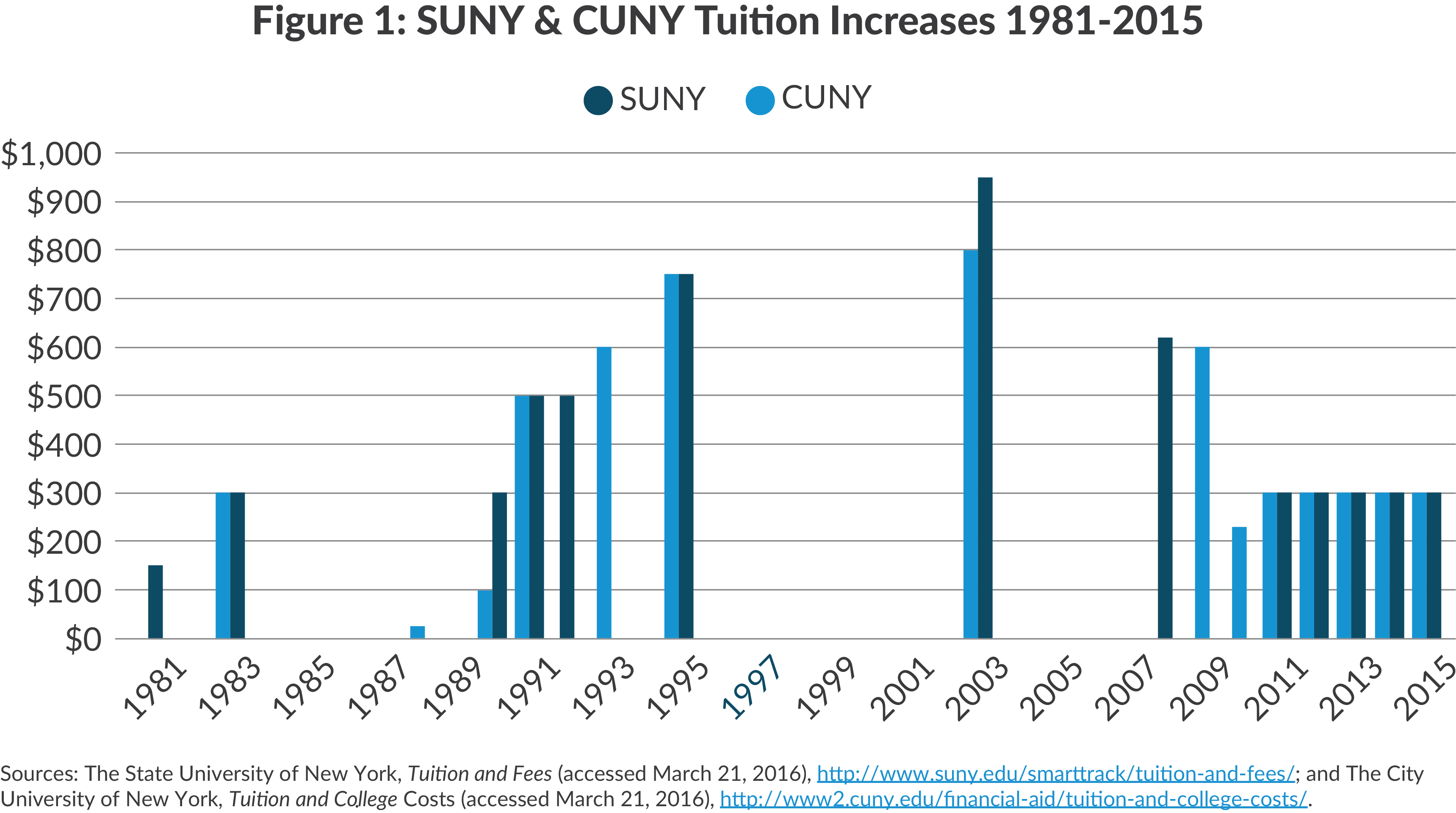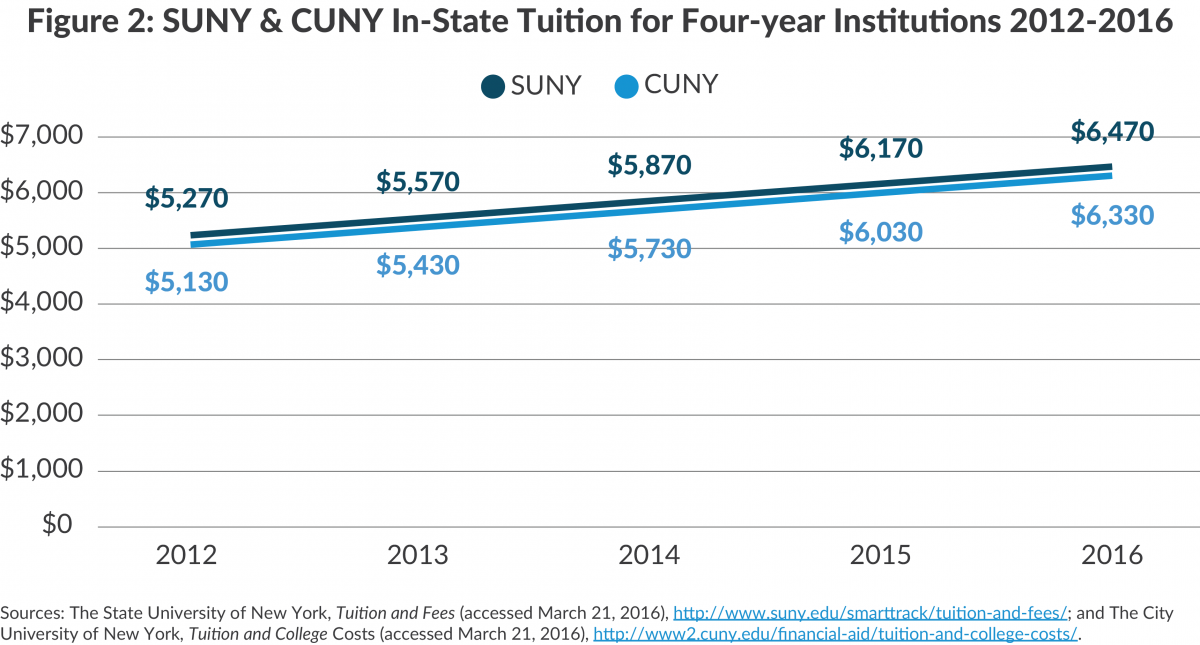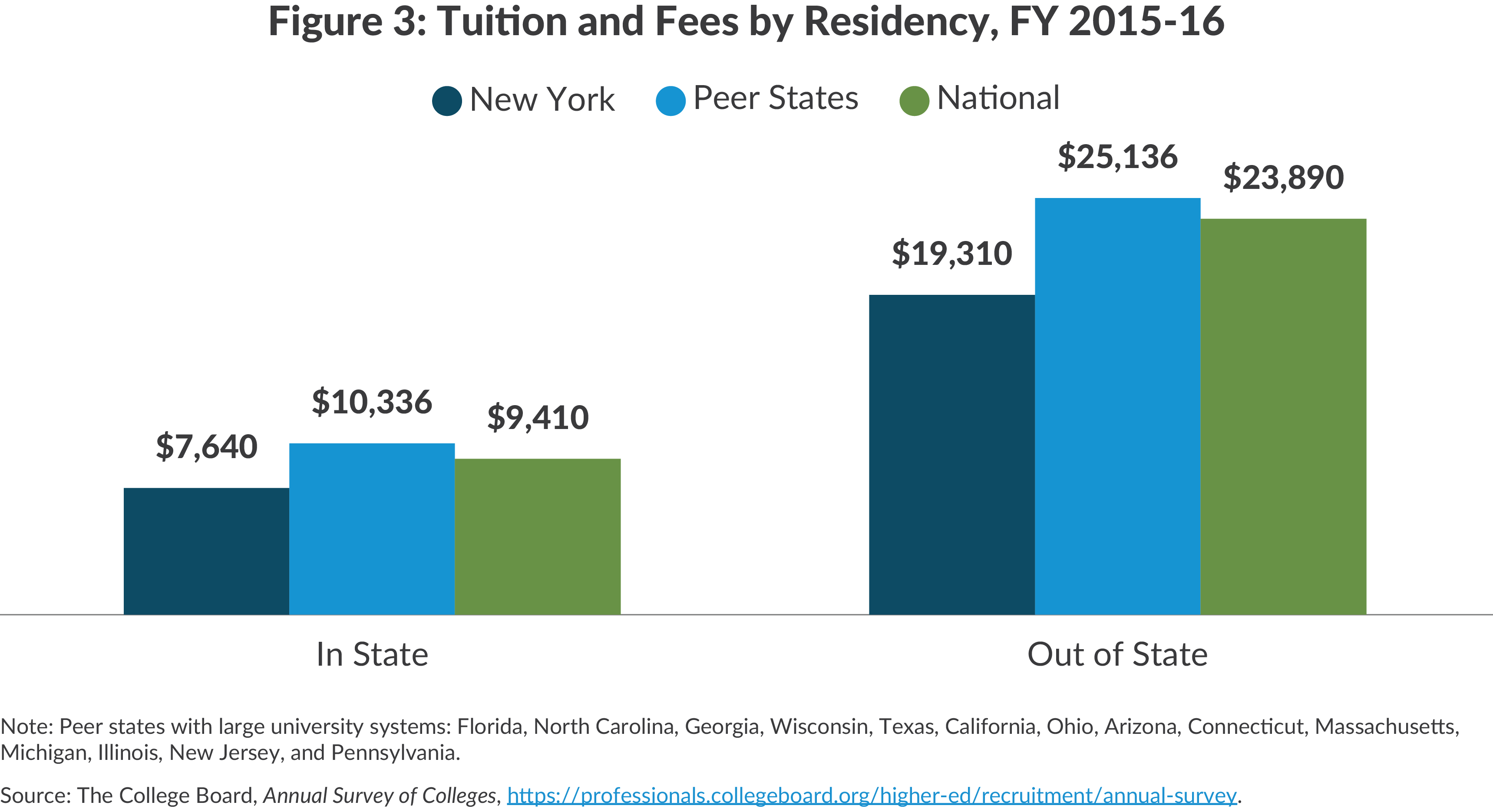The Rational Funding Plan for SUNY and CUNY Should Be Extended
In 2011 New York State adopted a five-year funding plan for the state’s public university systems that had two main provisions: a rational and predictable tuition plan and a maintenance of effort commitment from the State. The SUNY 2020 and CUNY 2020 Program authorized the State University of New York (SUNY) and the City University of New York (CUNY) to raise tuition by up to $300 per year. The State pledged to provide consistent financial support, rather than replace public investment with increased tuition. The additional revenue generated by tuition increases was to be utilized for improving education quality and providing financial assistance to students with limited incomes.1
The Executive Budget extends this successful program for an additional five years, until July 1, 2021.2 The one-house budget bills did not include the extension, but the final budget should.
Why a Tuition Policy was Necessary
Prior to this program, tuition increases at SUNY and CUNY were inconsistent. During recessions, state aid was cut, necessitating sudden and significant tuition increases. As Figure 1 shows, tuition was raised sharply during economic downturns when State revenues were tight, but remained unchanged during periods of economic stability. In contrast, as Figure 2 shows, tuition increased $300 per year at SUNY and CUNY since SUNY 2020 and CUNY 2020 was adopted, providing students with predictability. In 2015-2016, in-state tuition was $6,330 and $6,470 per academic year at CUNY and SUNY four-year institutions, respectively. With federal Pell grants and the state Tuition Assistance Program (TAP), these costs are further defrayed; in fact, 70 percent of CUNY students do not pay tuition.3
Since the enactment of this program the State has abided by the commitment to maintain its financial support, providing approximately $1 billion to SUNY and $1.2 billion to CUNY senior colleges annually.4
SUNY and CUNY Tuition Will Remain Competitive
Incremental tuition increases have not endangered New York’s ability to attract students, as SUNY and CUNY tuition rates remain a good deal. As Figure 3 shows, average in-state tuition and fees for public four-year undergraduate universities in New York is $7,640 compared to the national average of $9,410—approximately 19 percent lower.5 New York’s out-of-state tuition and fees also compare favorably—24 percent lower at $19,310 versus a national average of $23,890.6
New York’s tuition is also low relative to neighboring states and among states with large university systems.7 Average in-state tuition and fees is the lowest in the region, with mean tuition and fees of neighboring states 70 percent higher ($12,972) than New York. Likewise, New York public in-state tuition and fees is third lowest compared to peer states with large university systems, where mean tuition and fees is 35 percent higher ($10,336) than New York.8
Conclusion
Extending the SUNY 2020 and CUNY 2020 Program for another five years would extend tuition predictability and the state’s requirement to maintain public support, while maintaining New York’s competitive position.9 Failure to do so creates the possibility that SUNY and CUNY students could again be exposed to irrational and unpredictable tuition fluctuations, harming students, SUNY, and CUNY.
Footnotes
- The amount of financial assistance provided under this program to offset tuition increases was calculated by the Higher Education Services Corporation (HESC) based on a student’s Tuition Assistance Program (TAP) award.
- The Executive Budget also proposes to shift approximately $485 million in CUNY senior college costs from the State to the City, keeping combined support to CUNY stable compared to the current period. The proposed CUNY 2020 plan would then require the City and State to maintain the new shares for the next five years. CBC opposes this shift.
- James B. Milliken, “Trustee Breakfast with CUNY Chancellor James B. Milliken” (speech given to the Citizens Budget Commission, New York, N.Y., March 3, 2016), http://www.cbcny.org/content/breakfast-cuny-chancellor-james-b-milliken.
- The original program’s maintenance of effort provision required the State to provide financial support in an amount equal to or greater than the amount provided in the prior year. Last year, the State Legislature adopted legislation to amend the description of maintenance of effort beginning in 2016-2017 to include “all mandatory costs” of SUNY and CUNY, including contracted salary costs, fringe benefits, utilities, and rent. The legislature posited that the original intent of the program was to cover these costs. The Governor vetoed this bill – A5370 (Glick), and the extention proposed in the Executive budget maintains the original description.
- Comparisons to other states combine SUNY and CUNY, and also include average fees.
- CBC staff analysis of College Board, Trends in Higher Pricing 2015, http://trends.collegeboard.org/college-pricing and Annual Survey of Colleges (2015-2016), https://professionals.collegeboard.org/higher-ed/recruitment/annual-survey; and State University of New York, An Analysis of the Tuition Assistance Program (2016), http://www.capitalnewyork.com/sites/default/files/SUNY%20Tap%20Report.pdf.
- Neighboring states: New Jersey, Vermont, Massachusetts, Rhode Island, New Hampshire, and Connecticut. Peer states with large university systems: Florida, North Carolina, Georgia, Wisconsin, Texas, California, Ohio, Arizona, Connecticut, Massachusetts, Michigan, Illinois, New Jersey, and Pennsylvania. See: College Board, Annual Survey of Colleges (2015-2016), https://professionals.collegeboard.org/higher-ed/recruitment/annual-survey.
- CBC staff analysis of College Board, Trends in Higher Pricing 2015, http://trends.collegeboard.org/college-pricing and Annual Survey of Colleges (2015-2016), https://professionals.collegeboard.org/higher-ed/recruitment/annual-survey; and State University of New York, An Analysis of the Tuition Assistance Program (2016), http://www.capitalnewyork.com/sites/default/files/SUNY%20Tap%20Report.pdf.
- The current program and the Executive proposal contain different provisions requiring SUNY and CUNY to find cost savings and efficiencies. The current program requires an annual report on how each system is promoting fiscal stability by implementing cost savings after adopting tuition increases. The Executive proposal would provide that SUNY and CUNY trustees shall only increase tuition upon determination that cost savings are being implemented and that tuition increases are justified based on inflationary indices.


